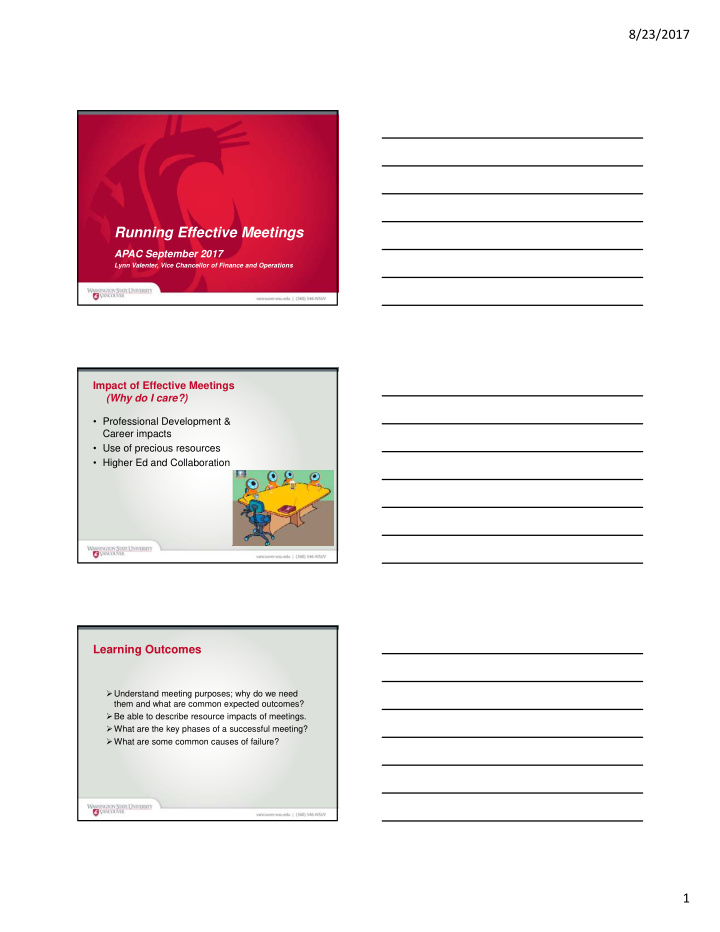



8/23/2017 Running Effective Meetings APAC September 2017 Lynn Valenter, Vice Chancellor of Finance and Operations Impact of Effective Meetings (Why do I care?) • Professional Development & Career impacts • Use of precious resources • Higher Ed and Collaboration Learning Outcomes Understand meeting purposes; why do we need them and what are common expected outcomes? Be able to describe resource impacts of meetings. What are the key phases of a successful meeting? What are some common causes of failure? 1
8/23/2017 Why have a meeting? Collaborative culture and Complex organization For the wonks (Parallel v sequential) Resource Impacts $ One of the most expensive forms of workplace communication $ Multiply number of attendees x hourly rate x (length of meeting, travel time and prep time) $ Balance against outcome(s) and alternatives $ Carefully consider length, attendees and frequency Overview of an Effective Meeting • Clear purpose, pre ‐ planning • Conducted well • Conclusions and follow up • Elements to avoid 2
8/23/2017 Clear Purpose Clear Purpose Information sharing Improve teamwork Agreements, decisions or solutions Do’s and Don’t s of Effective Meetings • Do’s • Don’ts 3
8/23/2017 Do’s and Don’t s of Effective Meetings • Do’s • Don’ts – Right people in the room X Flounder – Thoughtfully schedule, X Digress consider invitees everyone necessary, but stop there X Go on a tangent – Send reminders – Start/end on time – Follow the agenda – Manage the discussion – Shorter is better – Summarize key decisions and next steps – Confirm action items Meeting Agenda A Worthy Investment – Include start time, time allotted, end time – Time for major categories, not sub ‐ elements – Plan for Introductions, purpose/outcome statement – Note structure of key elements – presentation, overview, discussion, prioritization – Allowance for additions to agenda Enterprise Application Subcommittee May 29, 2015 AGENDA: 1. Introductions ALL 5 min 2. Overview of structure and purpose VALENTER 10 min • WSU Strategic Plan (attached) • ITEB • ITSAC • Enterprise Subcommittee (attached) 3. Discussion about projects and processes VALENTER/ALL 30 min ITS Project Review (attached) • ITS Scoring Rubric – Background (attached) • Case study for discussion – University Technology/Help Desk (attached) 4. Discussion about role in Enterprise Applications VALENTER 5 min – upcoming Human Resources/Finance enterprise 5. Path forward/logistics VALENTER 5 min • Collaborate site • Meetings • Availability/willingness to serve New Business ALL 5 min 4
8/23/2017 Facilitation • Formal training (Meeting Management & Facilitation) • Ground rules • Over/under contributors • Keep on track, parking lot, timing facilitation (one/two more comments) Facilitation Skills • Idea generation – List/flip chart – Contrast/color with pen – Brainstorming – Group individual, list until no new (nominal) – Sticky notes – Electronic submission in advance or in meeting – Facilitator/scribe if you’re running the meeting Facilitation Skills • Group decision ‐ making • What criteria will be used? • Consider methodology – Size of group – Relative knowledge – Compatibility, trust, group dynamics – Complexity, anonymity 5
8/23/2017 Facilitation Skills • Initial H,M,L • Elimination • Dots • Consensus – Color? • Vote – Multiple dots or no? • Commonalities – Must use all dots? • Matrix – Rank/prioritize • Rank Conclusions and Follow Up Protect the investment Decide who will follow up, by when Record/memorialize decisions Communicate results Effectiveness encourages future commitment Variable Elements Planning Process Culture Advance information Reminders Follow-up (minutes, action items, etc.) 6
8/23/2017 Summary 1. Meetings matter. Necessary and cost ‐ effective done well. 2. Pre ‐ planning is an investment. 3. Conducting a meeting includes tending to culture, discussion, agenda, timing and outcomes. Experience helps. 4. Conclusion/follow ‐ up is good stewardship of the investment. Minutes, summary, action items with time/person accountability and scheduling next steps protect the investment. 5. Know what can make a meeting ineffective and avoid. 6. Facilitation training valuable. Active Learning Need to generate budget reductions within your department/division. How would you structure an initial meeting? Who would you invite? What would the agenda look like? You’ve heard rumblings of unrest within a department. How might you structure a meeting to begin to address? You are chairing a committee that selects employee of the year. You have 15 nominations. How would you structure a meeting (or meetings) to determine your recommendation to the decision ‐ maker? You need to conduct a mandatory safety or awareness training. What would an agenda look like? 7
Recommend
More recommend